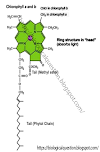Life cycle of Moss (Funaria)
The Life cycle of Moss Plant show two generations the sporophyte and the gametophyte, which regularly alternate with each other. lt is known as alternation of generation. The Life cycle is completed when the plant passes through these two generation.
The life cycle of moss can be summarized in the following stages:
Spore Germination:
The life cycle of moss begins with the germination of spores. These spores are usually released from the sporangium, a structure that holds and protects the spores. When the spores are released, they germinate and start to grow into thread-like structures called protonemata.
Gametophyte Phase:
The protonemata continue to grow and develop into the gametophyte, the sexual phase of the moss life cycle. The gametophyte is a small, leafy structure that produces both male and female reproductive organs, known as antheridia and archegonia, respectively.
Fertilization:
The sperm produced by the antheridia swim through a thin layer of water to reach the archegonia. The fertilization of the egg by the sperm results in the formation of a zygote.
Sporophyte Phase:
The zygote develops into the sporophyte phase of the life cycle. The sporophyte is a stalk-like structure that grows from the gametophyte and is attached to it by a foot. At the top of the sporophyte is a capsule, which contains spores.
Spore Release:
When the sporophyte is mature, the capsule opens and releases the spores. These spores are dispersed by wind or other means, and if they land on a suitable substrate, they will germinate and start the life cycle over again.
Senescence and Decay:
The gametophyte and sporophyte will eventually senesce and decay, releasing nutrients back into the environment to support the growth of other organisms.
The life cycle of mosses is an important part of the ecosystem, as they play a crucial role in the nutrient cycling process and provide habitat for a wide range of organisms.
Life cycle of Moss (Funaria)
Thank you for Reading the article.


.png)
.png)

.png)
0 Comments